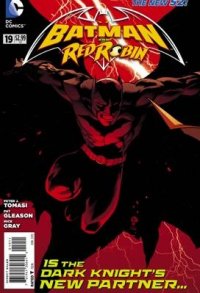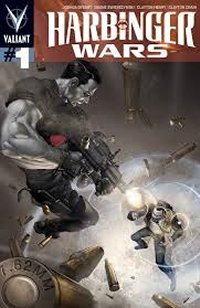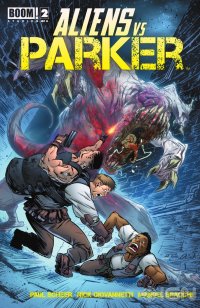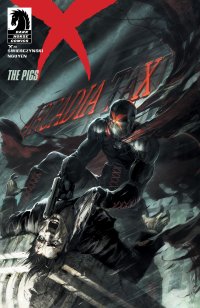Batman and Red Robin #19 ($2.99, DC Comics)
By Devon Sanders (@devonsanders)
I should be pissed. Like, seriously pissed off.
Carrie Kelley, the Robin from Frank Miller’s classic Batman: The Dark Knight Returns has been introduced into the New 52 universe proper and I should be pissed but I’m not.
I’m intrigued. I’m interested.
I should be enraged. Carrie Kelley was one of the characters whose story had been told. Frank Miller told it and walked away from it. Her story was done. And then, Frank Miller came back to the world he’d created with Batman: The Dark Knight Strikes Again and made us wish he’d left well enough alone.
So, when DC announced that she was making her New 52 debut, many of us shook our heads and were reminded of Before Watchmen, where beloved concepts were dusted off and recycled upon a whim.
I should’ve been pissed but this was happening in writer Peter Tomasi and artist Patrick Gleason’s Batman and Red Robin #19. It had the potential to be something other than horrific.
In the space of two years, Tomasi and Gleason in conjunction with Grant Morrison, created a complex, well-crafted exploration of “nature vs. nurture” while using Batman and Robin to explore the father/son dynamic between Bruce and Damian. In a very short time, they took Damian from tolerable to worthy of your care.
These were the guys handling Carrie Kelley’s introduction in the New 52 and I can tell you, they largely succeed.
Bruce Wayne, still trying his best to cope with the death of his son, receives a package upon his doorstep. The package is for Damian and opens up a side of his life his own father didn’t know about and in his quest to know more, a mystery begins to unfold. A young college student named Carrie Kelley wants to know why her young charge hasn’t been showing up to be tutored and only Bruce Wayne has those answers. Elsewhere, Bruce Wayne as Batman, descends into a place of heartbreak and resurrection and it’s left to Red Robin, Tim Drake to save what he can of The Dark Knight’s soul.
This comic beat me the hell up. No part of this comic should make any sense. From the introduction of an out-of-continuity character (Carrie) into the New 52 to the horrific and heartbreaking actions taken by Bruce Wayne/Batman to a highly unlikely and inspired guest star, Tomasi pulls it all off seamlessly while exploring the rift between Red Robin and Batman.
Artist Patrick Gleason pulls it all together beautifully. Gleason is not only one of comics’ best artist but one of its best designers. Not one single line is wasted and every background prop is used to tell you more about the character and their story. Gleason is rapidly becoming one of comics’ true master artists.
Batman and Red Robin #19 should have pissed me off. It didn’t. I never thought I’d want to see Carrie Kelly in this new universe. It’s a pretty dark place right now. What’s keeping me here (and this is such a great comic book “thing”) is that whenever you see her, the sun shines or she’s dancing or at a party. She’s exactly more of what the New 52 needs right now. Tomasi and Gleason gave her light. She seems hopeful.
She’s exactly what the New 52 needs more of right now.
Rating: 




Out of a Possible 5 Stars
 Harbinger Wars #1 ($3.99, Valiant)
Harbinger Wars #1 ($3.99, Valiant)
by D.S. Randlett (@dsrandlett)
I haven’t peeked in on X-Men in a while, but I assume that it’s pretty much business as usual with that franchise, in that it just ain’t what it used to be. This isn’t really the fault of the core conceit behind the X-Men (Civil Rights Superheroes!), but the landscape that surrounds that conceit has largely changed. Even today, it seems like the biggest Civil Rights struggle, LGBTQ rights, of this particular moment has reached a sort of tipping point. Granted there is still the need for that group to press on in terms of wider cultural acceptance, but even with that the movement has a feeling of inevitable victory surrounding it at the moment. Act Up seems to be barely a living memory to much of X-Men’s key demographic, and happened at a time when superhero comics were far too timid to take it on. The point being, with the last struggle that conformed to the X-Men’s basic iconography reaching a new phase, and the original struggle (mostly) having moved into a place more subtle than the concept (and maybe even the genre) can adequately address, the concept too winds down and retreats into what it frequently has in the past: soap opera. Further, attempts to reawaken the core concepts usually come off as too quaint or out of touch, or at the worst like a let’s-pat-ourselves-on-the-back-for-not-being-racist Edward Zwick film.
What keeps the reboot of Valiant’s nineties X-Men ripoff Harbinger from feeling like a post-2010 X-Men ripoff is that it understands the oppression hasn’t gone away, but become more equal opportunity. I think that writer Joshua Dysart (writer of Harbinger and co-writer of Harbinger Wars) gets the core appeal of what makes X-Men work, but smartly reframes how that core handles struggle, turning its eye from race and gender issues to class and youth issues. It ends up being a real shot in the arm to that core energy. Instead of a group of youngsters under the tutelage of a kindly MLK analog, you have a group of youngsters who have been awakened to great power by the strength of the previous generations of corporate and government establishments, only to be confined by those interests. It’s a keen superhero take on the Millennial experience: a generation born to the internet and the smartphone (superpowers of our very own) along with the standard American mythology reaches adulthood in debt in a world where every possibility seems to be contracting. Harbinger has been the superhero power fantasy of rebelling against those constraints, a sort of psychic road trip version of Occupy.
If Harbinger is the reframing of the X-Men to different concerns, the new Bloodshot is the reframing of Wolverine. Where Wolverine is the eternal old soldier, Bloodshot is the newly minted Iraq War veteran. Writer Duane Swierczynski’s run has been typified by badass action and cool techno-thriller ideas, but he’s also deftly used the healing factor and false memory conceits of the character to examine the experience of a veteran of the modern all volunteer American armed forces. Bloodshot is a nano-engineered warrior who has heretofore been used to eliminate potential threats (who tend to still be children), even though he is brainwashed into seeing himself as a rescuer and liberator being sent out for one last mission of good. I suppose that he has the benefit of forgetting each of his “tours,” unlike the Iraq War vets who have been sent back again and again, but the analog is pretty clear.
So here we have these two concepts, each derivative in their own ways but nonetheless vital, crossing over. Or at least beginning to. Harbinger Wars picks up where each series left off, and if you’ve been following Bloodshot and Harbinger, it’s pretty seamless. If you haven’t, you’ll just be lost despite the handy and rather cool infographic that greets you behind the cover. But then, greeting a new audience isn’t really the point here. The point is paying off a year of storytelling. And for that, it mostly works. It’s a first issue, so the story is in its earliest stages, but in terms of crossovers the writers and artists manage a real coup. All of the story here is new, and the conflict is clear. Superhero crossovers are typically predicated on some cosmic mishap or other, and as such they go about setting up a set of arcane rules about how the universe or an aspect of it operates. Harbinger Wars forgoes that in favor of a more grounded set of stakes, and this is all to the good.
The script has been worked on by both Dysart and Swierczynski, but you wouldn’t know it. They do an effective job of blending the voices of their respective series, but then it’s not as if their voices in those books were particularly distinctive. They both share a workmanlike quality to their prose which can feel a bit pedestrian, but both writers make up for it with their deft sensibilities for plotting and character. The art is very good, but there are far too many artists here. I’m not usually a stickler for this sort of thing, but the script is so cohesive that I think it would benefit from a single artistic voice. Each artist (there are three of them) does great work, but the variances in style keep the book from really feeling “whole.”
It’s yet to be seen if Harbinger Wars will pay off the potential of the concepts at the heart of Harbinger and Bloodshot, but the book is a success by being what many superhero crossovers refuse to be: a stripped down meat and potatoes action story with cool ideas and some heart. It doesn’t hurt that, like a soldier between his third and fourth tour and an unemployed graduate on the grounds of Zucotti Park, there are a lot of good reasons for these concepts to occupy the same space.
Rating: 




Out of a Possible 5 Stars
Aliens vs. Parker #1 & 2 (of 4)(Boom! Studios, $3.99) 
by Graig Kent
The year 2150 looks a little different from today, particularly the monstrous space freighters and military hardware and the Han Solo-inspired wardrobe. Otherwise, it’s not all that different. People still hate their jobs and are kind of petty and lazy…like Parker and the majority of the crew aboard a Space-Ex courier spaceship. They spend the bulk of their time in transport playing video games, being bored and not-so-good-naturedly ribbing one another. Things spice up a bit when they’re called in for a classified transport pick up, learning it’s a squad of beefed-up marines and their civilian detail, an obviously important woman named Presley.. Parker takes an immediate interest in Presley, in part because she’s able to match sophomoric wits with the boys, and somewhat inexplicably she seems to like him back. Their time together is to be short lived as she has a mission on the destination planet, which they arrive at in short order. Parker gets it into his head (or it’s put in his head by his buddy Modi) to abscond with a Space-Ex shuttle and visit Presley down on the planet, an ill-advised, job-(and life-)threatening idea.
The first issue features a decided absence of the titular aliens, instead providing solely the character set-up and motivation which initiates the story that the title implies. There is a fake-out in the opening pages however, which is at first a disconcerting sign about the quality of the series, but does prove amusing upon reveal. This extensive first-issue set-up should theoretically carry the characters through the rest of the series, which sees the ill-equipped Space-Ex crew square off against an alien menace/science experiment gone out-of control (predicting the future, they seem destined to do what the squad of marines failed to in this situation). It’s unfortunate then that the characters don’t strongly resonate nor do they transcend their group-of-bros set-up. There’s the slacker protagonist Parker, his best friend Modi who gives him pep talks, Kim, the angry one (or at least mildly annoyed all the time), the dim Lawrence, and their dink of a boss, Grey, whom they don’t even come close to respecting.
The series is the brainchild of comedian/actor/writer Paul Scheer and writer Nick Giovannetti, and naturally seems to be influenced by Aliens, Predator,and Aliens vs. Predator though it’s not a direct parody. It’s more of a genre comedy, in the vein of a Simon Pegg/Nick Frost film. I’ve been a fan of Scheer’s for years, his MTV sketch show Human Giant, FX’s The League, and his movie podcast “How Did This Get Made?” are all favourites of mine, and I know he has a love for comics, so I was keen to see how his comedic sensibilities would translate. It’s unfortunate that it doesn’t quite live up to expectations. The story isn’t the problem (it’s a tried and tested formula, that sense of “I know where this is going”, and I’m not bothered by that), but the humour largely falls flat. It’s a matter of timing, or the lack of timing that comics allow for. The dialogue is predominantly one-note, leaving the character’s voices largely indistinguishable, which wouldn’t be so troublesome with an actor bringing a physical/vocal performance to it. As it is, it’s all snappy patter all the time in a most unrealistic way.
We’re talking sci-fi and aliens here, so not everything needs to be believable, but at the same time, the constant need for rejoinders or wit interrupts any natural flow of conversation and is difficult to read overall. I get the distinct sense that Scheer and Giovannetti are still finding their comedic voices within the medium that they’ve otherwise honed on TV and on stage. It’s not painful, and it’s not terrible, it just feels forced.
They’re lucky in that they have a very talented illustrator in Manuel Bracchi, and whose art is clean and polished, with some animation influence, bearing a passing resemblance to Chris Sprouse (a bit sparse on the background details though). Bracchi’s expressive figures and faces are perfect for a comedy-oriented comic, but his talents are somewhat under-served. Scheer and Giovannetti’s script is primarily dialogue-oriented so Bracchi’s capable physical humour is rarely given the opportunity to shine (there’s a terrific panel where all the Space-Ex employees attempt to pass through a doorway at the same time, which is truly funnier in its set up than I write it here). His facial expressions go a long way to sell the dialogue, but it’s often not enough.
There’s the germ of a good genre-comedy here, and Scheer and Giovannetti are talented enough to pull it off, but they need more familiarity with storytelling in the medium and tailoring to their artist’s strengths to do so. Maybe with this first series under their belt a sequel or second effort from the team would prove more successful? It wouldn’t be unwelcome anyway.
Rating: 




Out of a Possible 5 Stars
 X #0 (Dark Horse, $2.99)
X #0 (Dark Horse, $2.99)
By Jeb D.
Comics Greatest World was another of the occasional attempts (this one from Dark Horse, back in the 90’s) to create from whole cloth the sort of integrated superhero universe that provided so much synergy (and cross-promotional marketing opportunity) for Marvel and DC. All such universes get a Superman analog (in this case, Titan), and there’s always a Dark Avenger, who is built largely from Batman’s DNA, but with some gene splicing courtesy of The Shadow or The Spider thrown in. When it came time for Dark Horse to introduce a murderous vigilante into the mix, though, a further element was added when they chose writer Steven Grant to script the adventures of the masked man known as X.
At the time, Grant was best known as the go-to writer for The Punisher; he had helped shape the character from a low-rent member of Spider-Man’s rogues gallery into Marvel’s most popular and enduring non-mutant character since the 60’s. He brought Frank Castle’s singleness of purpose to the enigmatic X, set him in opposition to organized crime more than supervillains, and by the end of the series had even given him a similarly murdered family as motivation. X lacked Batman’s colorful acoutrements and accessories, looking more street person than billionaire playboy, and operating in a costume designed to look like the ragged leftovers of a disused fetish shop: in other words, less Caped Crusader flair, more Punisher grit (they even got the best of both worlds when Frank Miller did a couple of Sin City-style covers for the series). The entire concept went under in short order, and X has been moldering (like Barb Wire, King Tiger, and the wonderful Mace Blitzkrieg) in Dark Horse’s back room for the past couple of decades. But intellectual property being what it is, even a failed superhero universe shouldn’t just sit around gathering dust when it can be mined for potential TV or movie adaptation (or possibly even to sell a few comics, though one sometimes wonders if that’s even a consideration anymore).
This latest version of X is, like the recent Ghost #0, compiled from recent issues of Dark Horse Presents. Unsurprisingly, it works a bit better this time: while Ghost always suffered (and continues to suffer) from the fact that no one seemed to completely grasp her concept, X’s concept is so pure and simple that it’s hard to put a foot wrong: this issue is a nicely self-contained introduction that could function as a standalone comic even if a new series wasn’t planned.
Writer Duane Swierczynski is (like Charlie Huston, Megan Abbott, and Raymond Benson) one of the clatch of crime novelists that have recently turned their hands to comic-book adventures of The Punisher, and it would take very little tweaking of this issue to substitute Frank Castle for the titular murderous badass. Some very bad mobsters (their enemies wind up as sausage) are being messed with by the brutal vigilante, and by gum, they’ve had enough of it! Ingenious plans are hatched to lure X into a trap, much gunfire ensues, lots of blood spurts, and there’s a twist ending to cap it off. All perfectly serviceable stuff, though in the wake of the intricate plotting, sharp character work, and bleak sense of dread that Garth Ennis, Jason Aaron, Greg Rucka, and their successors have achieved on the various recent permutations of the Punisher, X feels like something of an afterthought.
No complaints about the work of artist Eric Nguyen and colorist Michelle Madsen: the art in this issue is appropriately tough and arresting; frankly, it wouldn’t have looked out of place in a Punisher MAX book. If the art team stays together, they bring enough visual punch to carry a series like this, even if the story’s still looking for its own identity.
Rating: 




Out of a Possible 5 Stars